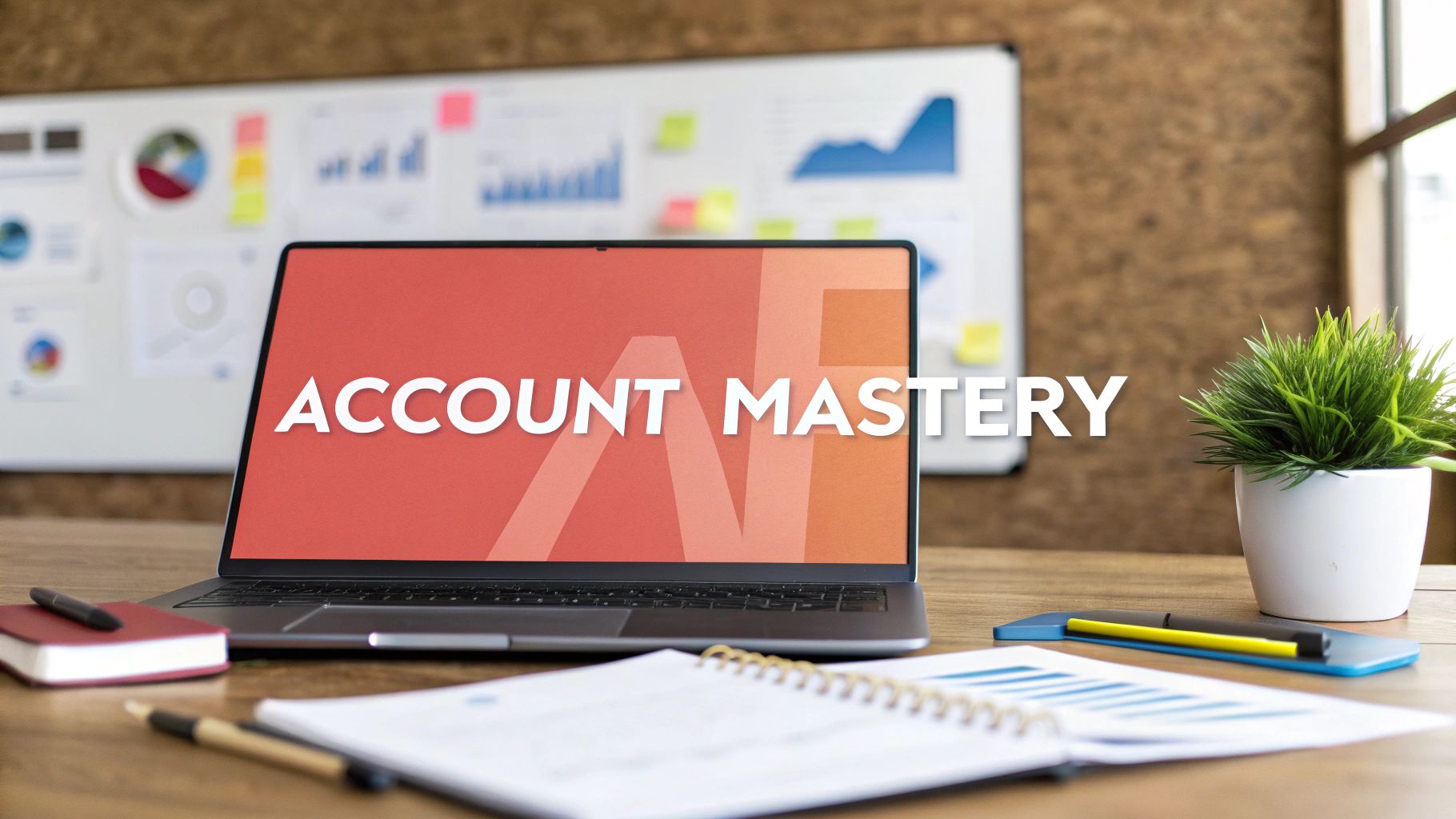In a competitive agency environment, retaining clients is just as critical as winning new ones. Yet, many agencies rely on reactive, outdated account management tactics that treat clients as mere projects instead of long-term partners. This approach no longer works. Simply keeping clients happy isn't enough; true success lies in becoming an indispensable part of their growth. This requires a strategic, proactive framework built on proven account management best practices.
This guide moves beyond generic advice to provide a comprehensive roundup of actionable strategies specifically for agency teams. We'll break down the essential practices that separate top-performing agencies from the rest, focusing on practical implementation rather than abstract theory. You won't find vague tips here, only concrete steps to elevate your client relationships from transactional to strategic.
From mastering client segmentation and proactive communication to leveraging data-driven analytics and strategic account planning, you will learn how to build a robust system for client retention and expansion. Each section offers clear examples and detailed guidance to help you not only meet but exceed client expectations, solidifying your agency's value and fostering sustainable growth. Let’s dive into the practices that will transform your agency's approach.
1. Segment Agency Clients for Strategic Prioritization
Not all agency clients are created equal, and treating them as such is a direct path to resource drain and missed opportunities. One of the most critical account management best practices for agencies is strategic client segmentation. This involves categorizing your client roster based on specific, measurable criteria to ensure your team's time and energy are invested where they will yield the highest return.
By moving beyond a one-size-fits-all service model, your agency can tailor communication, support levels, and strategic planning to each client's unique value. This proactive approach prevents your top-tier accounts from feeling neglected while ensuring that smaller clients receive appropriate, profitable service.
How Agencies Can Implement Strategic Segmentation
Effective segmentation goes beyond just revenue. A holistic view considers multiple factors to create a clear picture of each client's overall value to your agency.
Start by categorizing your clients into tiers (e.g., Tier 1, Tier 2, Tier 3) using a weighted scoring system based on criteria like:
- Current Revenue & Profitability: What is the account's monthly recurring revenue (MRR) and profit margin?
- Growth Potential: Is there a significant opportunity for upselling, cross-selling, or expanding services?
- Strategic Value: Does this client provide a powerful case study, offer valuable referrals, or give your agency prestige in a target industry?
- Relationship Health: How strong is the partnership? Do they trust your guidance and collaborate effectively?
Pro Tip: Create a simple spreadsheet to score each client on a 1-5 scale for these categories. The total score determines their tier, providing an objective framework for resource allocation and service-level agreements (SLAs). For example, Tier 1 clients might get a dedicated account director and quarterly in-person strategy sessions, while Tier 3 clients may receive support primarily through a shared inbox and standardized monthly reports.
2. Establish Proactive Communication Cadences with Clients
Reactive account management is a recipe for client churn. Instead of waiting for clients to raise issues, one of the most vital account management best practices for agencies involves establishing a cadence of proactive, value-driven communication. This means moving beyond transactional updates and creating a systematic approach to check-ins that build trust, uncover opportunities, and prevent problems before they start.
This strategy transforms the account manager from a simple point of contact into a strategic partner. By consistently demonstrating value and maintaining open lines of communication, your agency reinforces its commitment to the client's success, making the relationship deeper, more resilient, and ultimately more profitable. For a deeper dive into this topic, explore these client communication best practices.

How Agencies Can Implement a Proactive Communication Cadence
A successful communication strategy is planned, not improvised. It requires a clear framework that ensures consistency across your entire agency's client portfolio, much like the structured check-ins used by top-tier service firms.
Begin by defining a standard check-in schedule based on client tiers (as defined in segmentation):
- Establish Communication Preferences: At the start of the relationship, ask clients how they prefer to communicate- email, calls, or a shared Slack channel- and document it.
- Schedule Recurring Touchpoints: Book weekly, bi-weekly, or monthly check-ins in advance. This creates predictability and ensures communication never falls through the cracks.
- Prepare Value-Driven Agendas: Each meeting should have a clear purpose. Focus agendas on performance against goals, strategic insights, and future opportunities, not just past activities.
- Document and Follow Up: Use your CRM to log all interactions. Send a follow-up email after every significant conversation summarizing key decisions and outlining clear next steps.
Pro Tip: Create standardized templates for meeting agendas and follow-up emails within your agency’s project management tool or CRM. For a Tier 1 client, a monthly strategic call might review progress toward quarterly goals, while a Tier 3 client might receive a detailed monthly performance email with an option to book a call if needed. This ensures efficiency and consistent quality.
3. Gain Deep Expertise in Your Client's Business and Industry
Top-tier account managers are not just service providers; they are strategic partners who operate as an extension of their client's team. This transition from vendor to indispensable advisor is built on a profound understanding of the client's business, industry, and competitive landscape. This is one of the most critical account management best practices for agencies aiming to deliver true consultative value.
Moving beyond surface-level knowledge allows your agency to anticipate needs, identify unseen opportunities, and provide proactive solutions that align directly with your client's core objectives. It’s the difference between executing a requested campaign and co-creating a strategy that drives measurable business growth, solidifying your agency's role as an essential partner.

How Agencies Can Implement Deep Client Immersion
Achieving deep client and industry knowledge requires a structured, ongoing commitment to research and learning. This isn't a one-time onboarding activity but a continuous process of immersion for your agency team.
Start by formalizing your approach to client intelligence. Instead of relying on ad-hoc conversations, build a systematic process for gathering, documenting, and sharing insights across your team.
- Create Client Business Profiles: Develop a living document for each client that details their business model, revenue streams, key performance indicators (KPIs), target audience personas, and organizational structure. Update it quarterly.
- Immerse in Their Industry: Subscribe to the same industry publications your clients read. Follow key thought leaders and competitors on social media, and set up alerts for industry news.
- Attend Industry Events: Where possible, attend a key conference or trade show in your client's vertical. The insights gained from sessions and networking are invaluable for strategic conversations.
- Analyze Competitors: Conduct regular competitive analyses to understand what your client's rivals are doing successfully (and unsuccessfully). Present these findings to your client to spark new ideas.
Pro Tip: Schedule a quarterly "Industry Insights" meeting with your key client stakeholders. Instead of just reviewing your agency's performance, dedicate the session to discussing emerging trends, competitive shifts, and new opportunities you've identified for their business. This positions you as a forward-thinking strategist, not just an executor of tasks.
4. Align Internal Agency Teams for Seamless Delivery
Exceptional client service is rarely the work of a single individual. It's the result of a well-orchestrated effort across multiple agency departments. One of the most impactful account management best practices is fostering deep, cross-functional collaboration. This means breaking down internal silos between sales, project management, creative, and technical teams to present a unified, efficient front to the client.
When your agency's internal teams are aligned, the client experiences a seamless journey. Requests don't fall through the cracks, strategic goals are understood by everyone involved, and the final deliverables perfectly match the initial promise. This coordinated approach transforms your agency from a group of siloed specialists into an integrated client solutions team.

How Agencies Can Implement Cross-functional Coordination
Effective internal alignment requires a clear framework and dedicated tools to facilitate communication and shared accountability. The account manager's role is to act as the central hub, ensuring information flows freely and all teams are working toward the same client objectives.
Start by implementing these core practices to synchronize your agency's efforts:
- Establish Clear Roles: Create a Responsibility Assignment Matrix (RACI chart) for each major client account. This defines who is Responsible, Accountable, Consulted, and Informed for key tasks, eliminating confusion.
- Utilize Centralized Tools: Use a shared project management platform (like Asana, Monday, or Trello) to track all client-related tasks, deadlines, and communications. This creates a single source of truth for everyone.
- Conduct Regular Internal Syncs: Hold brief, weekly or bi-weekly internal meetings for each key account. This isn't for the client; it's for your internal team to align on progress, address roadblocks, and plan next steps.
Pro Tip: Create shared client dashboards using a business intelligence tool or even a simple Google Data Studio report. Pull in data from your CRM, project management software, and time tracking tools to give every team member real-time visibility into account health, project status, and budget utilization. This transparency empowers everyone to make informed, proactive decisions. For more ideas, you can find strategies to improve team collaboration.
5. Use Data to Monitor Agency Performance and Account Health
Gut feelings and anecdotal evidence are no longer sufficient for managing high-value agency accounts. One of the most impactful account management best practices is the systematic use of data to monitor performance, predict client needs, and make informed strategic decisions. This involves tracking key metrics that paint a clear, objective picture of account health and campaign effectiveness.
By embracing data-driven analytics, your agency can move from reactive problem-solving to proactive, strategic partnership. This approach enables you to spot warning signs like declining engagement before they become churn risks and identify upsell opportunities backed by solid performance data. It transforms conversations from subjective opinions to evidence-based strategies, building immense client trust.
How Agencies Can Implement Data-Driven Analytics
Integrating analytics into your agency's workflow requires defining what to measure and having the right tools to measure it. A successful framework ensures your team is tracking metrics that directly correlate with client success and agency profitability.
Start by establishing clear Key Performance Indicators (KPIs) for each account, linking your agency’s activities directly to the client's business goals. To track these, consider:
- Define Success Metrics: Collaborate with clients to define what success looks like. Is it lead generation, conversion rates, brand sentiment, or user engagement? These become your North Star metrics.
- Integrate Your Tool Stack: Ensure your CRM (like HubSpot or Salesforce), project management software, and reporting tools are integrated. This creates a single source of truth for all account data.
- Develop Account Health Scores: Create a scoring system that combines quantitative data (e.g., campaign ROI, service utilization) with qualitative insights (e.g., relationship strength) to flag at-risk accounts.
- Train for Data Literacy: Equip your account managers with the skills to not just read reports but to interpret the data, identify trends, and formulate actionable plans.
Pro Tip: Create standardized account performance dashboards in a tool like Tableau or Google Data Studio for each client tier. These dashboards should visualize progress against KPIs, campaign ROI, and service utilization. Review them in every internal account meeting to ensure decisions are consistently backed by data, not just assumptions.
6. Create Strategic Account Plans for Client Growth
Reactive account management leads to stagnation. To truly become an indispensable partner, your agency must move beyond day-to-day task execution and embrace proactive, long-term strategic planning. This is where creating detailed, written account plans becomes one of the most vital account management best practices for sustainable growth.
A strategic account plan is a formal document that serves as a roadmap for an individual client relationship. It outlines their business objectives, identifies growth opportunities for the agency, anticipates competitive threats, and defines the specific actions your team will take to deliver value. This transforms your role from a service provider into a strategic advisor invested in their long-term success.
How Agencies Can Implement Strategic Account Planning
Building a robust account plan requires a deep understanding of the client's business, not just their immediate marketing needs. It’s a collaborative blueprint for mutual success, ensuring both teams are aligned on a shared vision.
Start by developing a standardized template for your agency that includes sections for:
- Client Business Objectives: What are their high-level company goals for the next year? (e.g., increase market share by 10%, launch a new product line).
- Key Performance Indicators (KPIs):: How will your agency measure success? Define specific, quantifiable metrics that align with their objectives.
- Growth Opportunities: Where can your agency add more value? Identify potential upsell or cross-sell services that solve their upcoming challenges.
- Relationship & Stakeholder Map: Who are the key decision-makers, influencers, and potential detractors within the client's organization?
- Action Plan & Timeline: What are the specific short-term tactics and long-term initiatives for the next quarter and year?
Pro Tip: Involve the client directly in the planning process. Schedule a dedicated annual or bi-annual strategy session to co-create the account plan. This builds immense trust and ensures your proposed initiatives are perfectly aligned with their internal priorities, making budget approval for new projects significantly easier. Review and update this living document quarterly to stay agile.
7. Adopt a Consultative Approach to Drive Client Value
Exceptional agency account managers don't just fulfill service agreements; they act as strategic partners who actively create new value for their clients. Shifting from an order-taker to a consultative advisor is one of the most impactful account management best practices an agency can adopt. This approach involves deeply understanding a client's business to proactively identify opportunities for process improvements, cost savings, or new revenue streams.
By positioning your team as indispensable strategic thinkers, you move the conversation beyond deliverables and deadlines to focus on tangible business outcomes. This not only strengthens the client relationship but also naturally uncovers opportunities for upselling and cross-selling, driving organic growth for your agency.
How Agencies Can Implement Consultative Selling
Becoming a value creator requires a fundamental shift in mindset from "what are we supposed to do?" to "what business problem can we solve?" To truly become a value creator and avoid being an order-taker, mastering the art of effective strategies for managing changing client requirements is paramount for agency teams.
Start by training your account managers to focus on these key areas:
- Quantify Value Propositions: Instead of saying a new service is "better," explain that it can "reduce customer acquisition cost by 15%." Always tie your recommendations to specific, measurable business metrics like revenue growth, cost reduction, or efficiency gains.
- Focus on Business Outcomes: Frame your solutions around the client's strategic goals, not your agency's service features. For example, rather than selling "a new SEO campaign," sell "capturing a larger market share from your top competitor."
- Develop Business Acumen: Encourage your team to learn the client’s industry, competitive landscape, and internal processes. This expertise is the foundation for providing credible, high-impact recommendations.
- Build a Library of Success Stories: Create detailed case studies that showcase how your agency solved a similar problem for another client, complete with data and testimonials. This provides powerful social proof.
Pro Tip: During your next Quarterly Business Review (QBR), dedicate a specific agenda item to "Future Opportunities." Instead of just reporting on past performance, present one or two well-researched, data-backed ideas for a new initiative that aligns with the client's high-level goals. This frames your team as forward-thinking partners invested in their long-term success.
8. Implement Proactive Risk Management and Issue Resolution
Even the strongest agency-client partnerships face turbulence. A crucial aspect of effective agency work involves not just reacting to problems but anticipating them. This is where proactive risk management, another key account management best practices, becomes invaluable. It’s about creating systems to identify potential threats to project timelines, budgets, and relationship health before they escalate.
When issues inevitably arise, having a structured resolution process is what separates top-tier agencies from the rest. A swift, transparent, and empathetic response can turn a potential disaster into an opportunity to build even deeper client trust, demonstrating your agency's commitment and professionalism.
How Agencies Can Implement Proactive Risk & Resolution
Building a resilient account management framework requires a two-pronged approach: one part foresight and one part structured response. This ensures your agency team is never caught off guard and always has a clear path forward.
Start by integrating these processes into your regular client management rhythm:
- Develop a Risk Register: For key accounts, maintain a simple document that lists potential risks (e.g., key stakeholder departure, budget cuts, technology failure), their likelihood, potential impact, and a pre-planned mitigation strategy.
- Establish Clear Escalation Paths: Define exactly who in the agency needs to be involved and when. For example, a minor scope creep issue might be handled by the Account Manager, but a significant budget overage requires immediate escalation to an Account Director.
- Train for Crisis Communication: Equip your team with scripts and guidelines for communicating bad news. The focus should be on taking ownership, clearly explaining the issue, presenting a solution, and outlining next steps.
- Conduct Post-Mortems: After resolving a significant issue, hold an internal meeting to document what happened, why it happened, and what processes can be improved to prevent it from recurring.
Pro Tip: Create an "Issue Resolution Playbook" that standardizes your agency's response. This document should outline the steps for logging the issue, the escalation matrix, approved communication templates for different scenarios, and a checklist for the post-mortem process. This ensures every team member responds with consistency and professionalism, protecting both the client relationship and the agency's reputation.
9. Focus on Continuous Relationship Building with Stakeholders
Exceptional agency account management transcends transactions and project deliverables; it's about cultivating deep, resilient partnerships. A cornerstone of account management best practices is the ongoing effort to build and maintain trust with key client stakeholders. This isn't a one-time task but a continuous process of proving reliability, demonstrating authentic interest, and consistently delivering on promises.
By investing in genuine relationships, your agency transforms from a mere vendor into an indispensable strategic partner. This deep-seated trust provides a buffer during challenging projects, encourages client advocacy, and creates a foundation for long-term growth and loyalty. It’s the difference between a client who stays for the price and one who stays for the partnership. Learn more about the fundamentals of client relationship management.
How Agencies Can Build Lasting Client Trust
Developing authentic relationships requires a systematic and personalized approach that goes beyond standard check-in calls. It involves understanding the people behind the titles and consistently adding value.
Focus on these core actions to embed relationship-building into your agency's process:
- Map Key Stakeholders: Identify everyone who influences the account, from the day-to-day contact to the ultimate decision-maker. Understand their roles, motivations, and communication preferences.
- Invest Beyond Business: Take the time to understand your clients' personal career goals and challenges. How can your agency help them succeed individually? A small gesture, like sharing a relevant article or industry connection, can have a huge impact.
- Demonstrate Unwavering Reliability: Consistently follow through on all commitments, no matter how small. Reliability is the currency of trust.
- Practice Proactive Transparency: Address potential issues head-on before they become major problems. Being upfront, even with bad news, shows integrity and strengthens the client’s confidence in your partnership.
Pro Tip: Create a "Stakeholder Relationship Map" for each key account. This simple document can list each contact, their role, their key business objectives, and personal interests or communication styles noted during conversations. Use this to personalize interactions and ensure every communication adds value, cementing your agency's role as a trusted advisor.
Agency Account Management Best Practices: A Comparison
Transforming Your Agency from a Vendor to a Partner
Navigating the complexities of client relationships in an agency setting is a continuous journey, not a destination. The difference between a transactional vendor relationship and a deeply embedded strategic partnership often comes down to the consistent application of robust account management best practices. We have explored a comprehensive framework, moving from foundational strategies like client segmentation and proactive communication to advanced tactics involving data-driven analytics, strategic planning, and continuous value creation.
The core theme connecting all these practices is a fundamental shift in mindset. It’s about moving beyond simply delivering services to truly understanding and contributing to your client's core business objectives. It's the difference between completing a task list and becoming an indispensable advisor who anticipates needs, mitigates risks, and actively uncovers new opportunities for growth. Mastering this requires a commitment to excellence across your entire team, from the account manager leading the charge to the specialists executing the work.
Your Agency's Path to Partnership: Key Takeaways
To truly elevate your agency's account management, focus on integrating these pivotal concepts into your daily operations:
- Embrace Proactive Engagement: Don't wait for your clients to come to you with problems or requests. The best account managers are always one step ahead, using regular check-ins, industry insights, and performance data to guide the conversation and demonstrate forward-thinking value.
- Operationalize Your Strategy: Abstract goals are meaningless without a concrete plan. Use strategic account plans not as static documents but as living roadmaps. Connect these plans directly to your data analytics and performance monitoring to create a feedback loop that informs every decision.
- Cultivate Deep Business Acumen: Your agency's value multiplies when you understand the client's industry, competitive landscape, and internal pressures as well as they do. This deep knowledge is the foundation for consultative selling and building unshakeable trust.
- Foster Internal Collaboration: Exceptional client service is a team sport. Break down internal silos and ensure seamless cross-functional collaboration. When your design, development, and marketing teams are aligned with the account strategy, the client experiences a unified, powerful partnership.
Actionable Next Steps for Your Agency
Putting these principles into practice is what separates leading agencies from the rest. Start by selecting one or two key areas for immediate improvement. For instance, you could implement a more structured client segmentation model this quarter or introduce a standardized template for strategic account planning.
Next, conduct an internal audit of your communication protocols. Are they proactive enough? Are you leveraging data effectively in your client conversations? Empower your team with the training and tools they need to execute these account management best practices flawlessly. The ultimate goal is to create a culture where every team member sees themselves as a guardian of the client relationship, constantly working to transform your agency from just another vendor into an essential, long-term partner. This evolution is the key to sustainable growth, higher client retention, and a stronger reputation in the market.
Ready to supercharge your client meetings and ensure every critical insight is captured and actioned? Scribbl provides AI-powered meeting notes, summaries, and action items, allowing your account managers to focus on the conversation, not the note-taking. Implement a key account management best practice today by trying Scribbl to build smarter, more productive client relationships.




